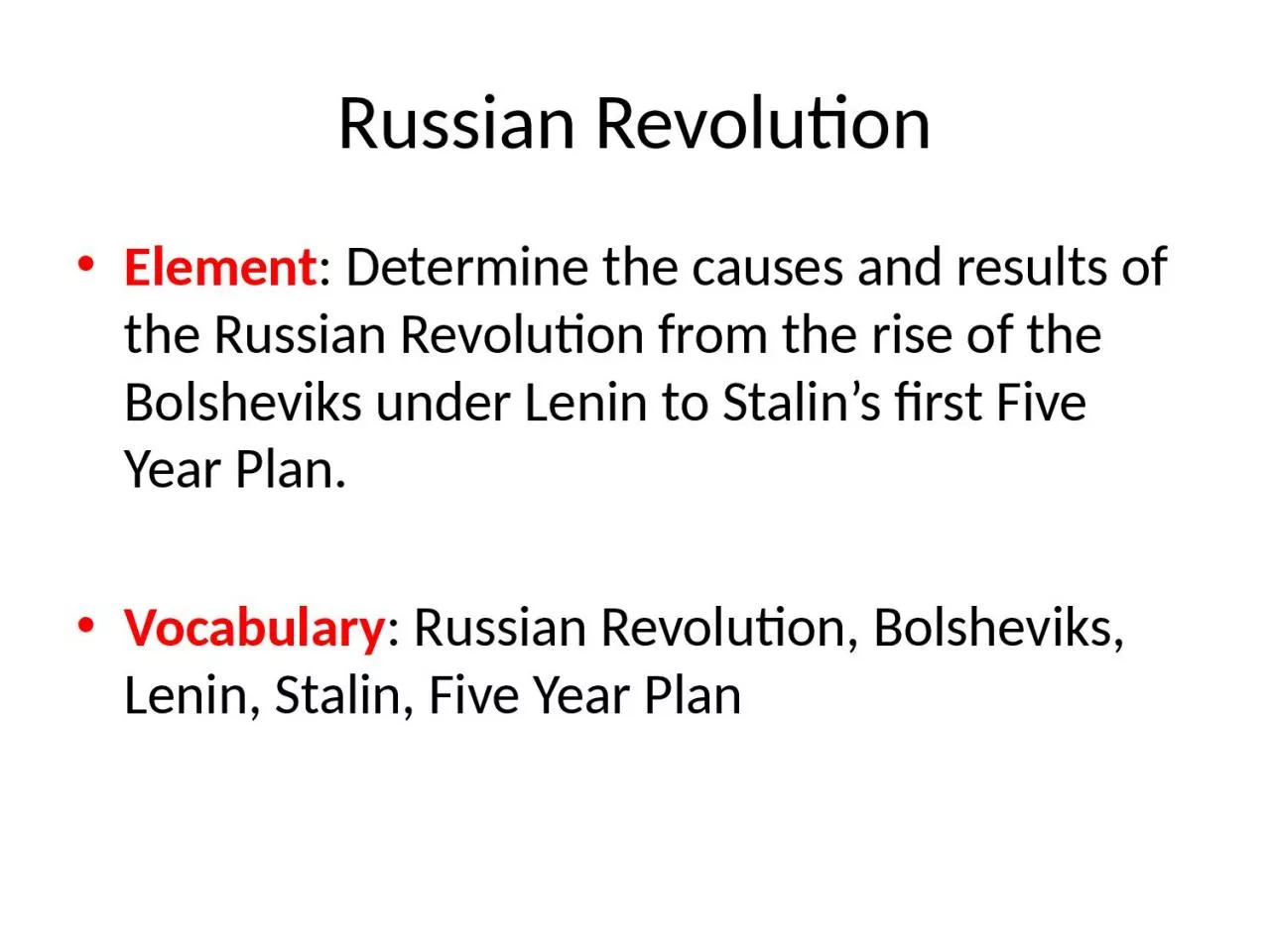

Determine the causes and results of the Russian Revolution from the rise of the Bolsheviks under Lenin to Stalins first Five Year Plan Vocabulary Russian Revolution Bolsheviks Lenin Stalin Five Year Plan ID: 935177
Download Presentation The PPT/PDF document "Russian Revolution Element" is the property of its rightful owner. Permission is granted to download and print the materials on this web site for personal, non-commercial use only, and to display it on your personal computer provided you do not modify the materials and that you retain all copyright notices contained in the materials. By downloading content from our website, you accept the terms of this agreement.
Slide1
Russian Revolution
Element
: Determine the causes and results of the Russian Revolution from the rise of the Bolsheviks under Lenin to Stalin’s first Five Year Plan.
Vocabulary
: Russian Revolution, Bolsheviks, Lenin, Stalin, Five Year Plan
Slide2Czarist Russia
under Nicholas II
lagged behind the rest of Europe
technology was not as advancedlacked modern industrializationentered World War I and was not prepared for warthe nation was poormany peasants were starving
Slide3Russian Society under the Czar
Czar Nicholas II –absolute power
all documents were censored
Russian was the only legal language in the empireSecret Police sent violators to Siberia
Slide4Impact of World War I
exhausted more money and food away from Russia’s citizens to support the war effort
millions of Russians, both soldiers and civilians, suffered and died
the czar became more unpopularpeople of all classes began calling for change in the Russian government
Slide5Industrialization leads to problems
Factory work consisted of terrible working conditions, child labor, low wages, and no unions
Revolutionary movements were starting
Slide6Karl Marx
Communism- a system in which all private property is owned by the community and shared by all.
He believed wealth should not be in the hands of a few.
The proletariats or working class should revolt and rule the country.
Slide7Uprisings
erupted in 1917
among the lower working classes, strikes broke out
objected to involvement in WWICzar Nicholas II ordered troops to put down the uprisings
Slide8March Revolution
many soldiers switched sides and joined the rebellious crowds
Czar Nicholas II abdicated (step down) the throne on March 12
Slide9Provisional Government
Government in hands of Duma (Parliament)
Provisional(temporary) government takes over
led by Alexander KerenskyRussia stays in World War IRussian people continued to suffer
Slide10Rise of the Bolsheviks
Vladimir Lenin
:
Bolsheviks- Radical group of Marxists in RussiaVladimir Lenin led this groupopposed Czarist regimefled from Russia in the early 1900s to avoid arrest
Slide11Out of Exile
Lenin returned in 1917 with support of Germany
the Bolsheviks overthrew the government
Slide12Bolshevik Revolution
Promised to redistribute land and food to the poor, put power in the hands of the people, and pull Russia out of World War I
soon seized control of the Russian Government
sign peace treaty with Germany and leave World War I
Slide13Reds vs. Whites
three year civil war
between the Reds- supporters of Bolsheviks, and the Whites-opponents of the Bolsheviks
after 14 million dead the Reds won
Slide14White Army support
allied countries (Great Britain, France, Japan, and the United States) also sent troops to Russia to support the anti-Communist forces
wanted to encourage Russia to re-enter the war
Slide15Results of the Russian Revolution
by 1921 Russia was firmly Communist
leaders never forgot the way Western nations sided with the anti-Communists
start of mistrust between the West and Communist Easttransfer of power in Russia from aristocrats to leaders from the lower classes
Slide16Industrial Age of Russia
Russia ushered into the industrial age
people moved out of the country and into the cities
importance of education to catch up to the WestBolsheviks determined to become self-sufficient from Western Europe
Slide17Establishment of the Soviet Union
Challenges
:
famine killed millions in Russianation’s industry collapsedLenin introduced New Economic Policyallowed a limited amount of private ownership, while still maintaining state control over large industries and banks
Slide18USSR
The Union of Soviet Socialist Republics
established in 1922 by the Communist Party
improved agricultural conditions and new policies revived the economyLenin died in 1924
Slide19New Leadership
Leon Trotsky
:
lead the army during the Bolshevik Revolution and the Russian Civil Waropposed to Lenin’s economic changes
Slide20New Leadership
Joseph Stalin
:
joined the Bolsheviks in 1903
won Lenin’s favor after leading a bank robbery to get money for the party’s causebecame general secretary of the party under Lenin
Slide21Stalin’s Rise to Power
responsible for appointing people to important party posts
used his position to appoint people who later helped him seize and maintain his power
emerged as the nation’s dictator
Slide22Stalin’s Economy
Soviet Union was behind Western Europe
Command Economy
- Govt. makes all economic decisionswomen were granted equal rights and forced to enter workforce
Slide23Stalin’s Five Year Plan
a plan for economic and military development
high quotas to meet in the production in industry (Steel, coal…)
Citizens often felt shortages on food, clothing, and housing.
Slide24The Purge
eliminated those perceived to be a threat
Bolshevik leaders and a number of military officers tried and convicted of crimes
many were executed others shipped to Siberian prison campsTrotsky fled to Mexico, only to be murdered with a pickax in 1940 Stalin murdered millions of his own people before the end of his regime in 1953